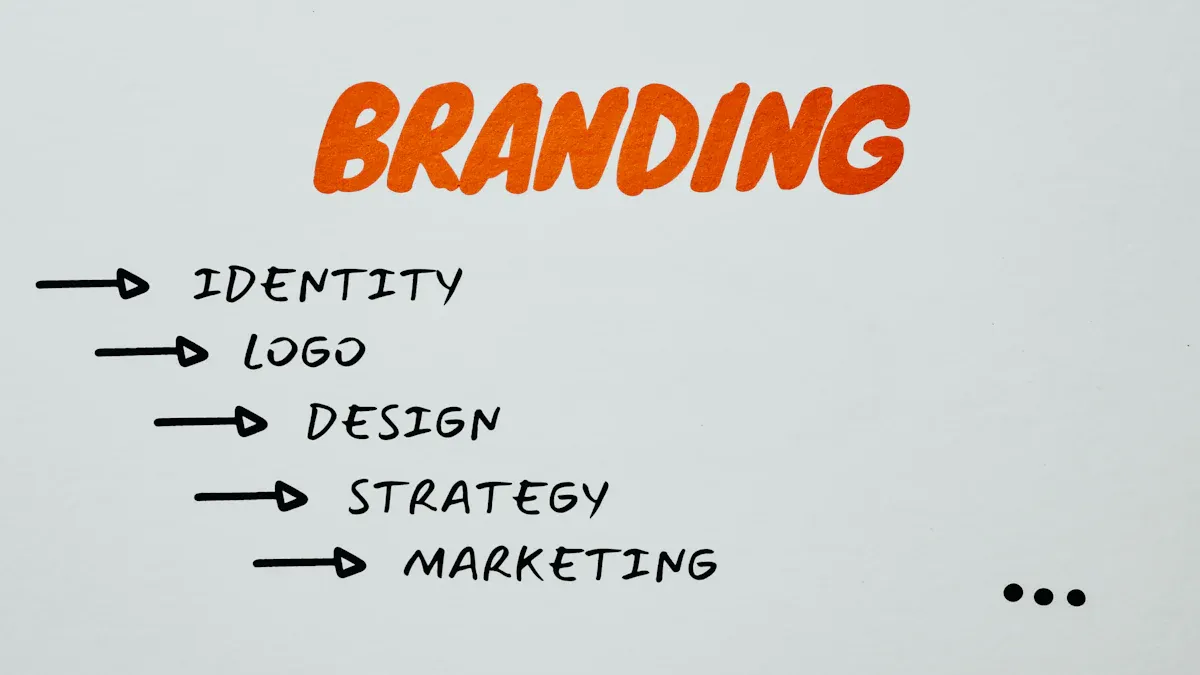
Brand Style Guide Template: Elevate Your Identity
Table Of Contents
Why Modern Brands Need Style Guidelines

A clear brand identity helps build customer connections and market presence. The brand style guide serves as the foundation for creating this identity, ensuring your message stays clear and consistent everywhere your brand appears. Think about the last time you visited a website with mismatched design elements and unclear messaging – it probably didn't inspire much confidence.
Brand coherence matters because it creates recognition and trust. A style guide provides the framework to keep all your brand elements aligned – from social posts to website content. When customers see consistent branding, they develop familiarity and trust in your company. Research shows that brands maintaining consistent presentation are 3.5 times more visible to customers compared to those with inconsistent branding. Learn more about creating effective brand guidelines in this detailed guide.
The Benefits of a Unified Brand Identity
A well-crafted style guide delivers several key advantages:
-
Improved Brand Recognition: When your visual identity stays consistent, customers can spot your brand quickly across different channels. This recognition is crucial for standing out in busy markets.
-
Enhanced Customer Trust: People trust what's familiar. A unified brand experience builds credibility with your audience, making them more likely to choose your products and services.
-
Increased Team Efficiency: Clear guidelines help content creators and designers work faster and more effectively. This means fewer revisions and quicker project completion.
-
Better Growth Potential: As your company expands to new markets, style guidelines ensure your brand stays recognizable and trustworthy, no matter how much you grow.
Key Elements of a Brand Style Guide
An effective style guide should include:
-
Logo Usage: Clear rules for logo placement, spacing, and approved variations to maintain visual consistency.
-
Color Palette: Specific brand colors with exact hex codes to ensure perfect color matching across all materials.
-
Typography: Standard fonts and text styles that create a professional, cohesive look.
-
Brand Voice and Tone: Guidelines for writing style and communication that reflect your brand's unique personality.
A thorough style guide becomes your brand's north star, keeping your identity strong and recognizable. It's a smart investment that helps your brand connect with customers and stand apart from competitors. The next sections will explore how to choose the right template format and build out these core elements for maximum impact.
Selecting Your Perfect Template Format
A brand style guide template shapes how your brand looks and speaks to the world. Picking the best format affects how easily your team can use, adapt, and maintain brand standards. Let's explore different template options to help you find what works best for your needs.
Digital vs. Print: Weighing Your Options
Most teams need to decide between digital and print formats. Digital templates in tools like Google Docs, Microsoft Word, or Keynote let you quickly share and update your guide from anywhere. Print templates made in Adobe InDesign work well for design-focused brands that want a physical reference. Think about your needs – if your brand evolves often, go digital. If visual design is your priority, print might be better.
Exploring Specific Software Solutions
Each tool offers unique benefits for style guides. The Futur provides ready-made templates for InDesign, Keynote, and Adobe XD – perfect for customizing typography, grids, and colors. Adobe XD excels at interactive guidelines with clickable prototypes. InDesign gives precise control over print layouts. Word works well for text-heavy guides, while Google Docs enables real-time teamwork.
Key Considerations for Choosing a Format
Before deciding, think about:
- Accessibility: Do people need to access the guide remotely? Digital might be best
- Updates: How often will you revise the guide? Digital makes changes easier
- Team Skills: Are your people comfortable with design software, or would simpler tools work better?
- Brand Focus: Does your brand emphasize visuals? Consider InDesign or print formats
You might be interested in: Our sitemap for related content
Template Format Comparison
Here's a helpful overview of different format options:
| Format Type | Best For | Key Features | Ease of Use |
|---|---|---|---|
| Digital (Google Docs/Word) | Remote teams needing frequent updates | Quick sharing, version tracking | High |
| Digital (Keynote/PowerPoint) | Visual-first guides | Rich graphics, simple navigation | Medium |
| Digital (Adobe XD) | Web/app guidelines | Interactive demos, design tools | Medium |
| Print (Adobe InDesign) | Design-focused brands | Typography control, print quality | Medium to Low |

Picking the right brand style guide template format sets you up for success. Take time to evaluate your needs and explore options to create guidelines that work for your team and strengthen your brand.
Crafting Your Guide's Core Elements

Think of a brand style guide like building a house – the template provides the foundation, but the core elements give it life and character. These essential components work together to create a recognizable brand identity that connects with your audience. Let's explore the key building blocks that make your guide truly effective.
Logo Usage Guidelines: Protecting Your Brand Mark
Your logo serves as the face of your brand. Clear guidelines ensure it maintains its impact across all uses. Be specific about:
- Minimum size requirements
- Required white space around the logo
- Approved color variations
- Placement rules
These details help prevent common mistakes that could weaken your brand's visual impact.
Typography: The Art of Consistent Font Choices
Fonts shape how people perceive your brand's personality. Just like choosing the right outfit for different occasions, each font serves a specific purpose. Your guide should clearly specify:
- Header fonts
- Body text fonts
- Font sizes and weights
- Where and when to use each font
Color Palette: Creating Visual Recognition
Colors trigger emotional responses and help people recognize your brand instantly. Your guide needs to include:
- Primary brand colors with exact hex codes
- Secondary and accent colors
- Rules for color combinations
- Examples of proper color usage
This level of detail ensures your brand colors stay consistent everywhere.
Brand Voice and Tone: Speaking With Purpose
Words matter as much as visuals. Your brand voice guidelines should outline:
- Writing style and tone
- Common phrases to use
- Words or phrases to avoid
- Examples of good and bad content
Learn more about creating effective brand guidelines at Venngage's Brand Guidelines Guide.
Brand Personality: Bringing Your Brand to Life
Think of your brand as a person – what traits define them? Document your brand personality by:
- Describing core values
- Explaining brand character traits
- Showing how these translate to communication
- Providing real examples
This helps content creators truly understand and reflect your brand's spirit. You might find our sitemap article helpful for organizing these elements.
Building a Flexible Framework
While consistency is key, your guide should allow room for creative expression. Include examples showing how brand elements adapt to different needs while maintaining core identity. For instance:
- Logo usage on various backgrounds
- Seasonal color variations
- Voice adjustments for different channels
- Design flexibility within brand parameters
This balanced approach keeps your brand consistent yet fresh as marketing needs evolve.
Personalizing Your Template for Maximum Impact

A brand style guide template sets the foundation, but its real value emerges through personalization. Each brand tells a unique story – your style guide should capture and express what makes your brand special. By adapting the template thoughtfully, you'll create a practical tool that your team will actually use.
Adapting Visual Hierarchy and Content Organization
Think of your style guide as a map guiding people through your brand. Clear signposts and logical flow make it easy to navigate. Focus on organizing information in a way that highlights what matters most for your specific brand. If visuals drive your brand identity, give extra attention to logo guidelines and color specs. Add clear section breaks and headers to help your team quickly find what they need.
Strategic Customization: A Step-by-Step Approach
Start by defining your core brand values and voice – these shape which elements need emphasis. Next, review the template structure and note where you need to make adjustments. You might expand the brand voice section, add more logo examples, or create entirely new sections. Get input from your team throughout this process to ensure the guide works well in practice.
Customization Checklist: Tracking Essential Elements
Here's a practical checklist to help you customize your style guide effectively while keeping track of must-have and optional components:
| Element | Must-Have | Optional | Notes |
|---|---|---|---|
| Logo Usage | ✅ | Include variations, clear spacing rules, and incorrect usage examples. | |
| Color Palette | ✅ | Specify hex codes, Pantone equivalents, and usage guidelines for primary, secondary, and accent colors. | |
| Typography | ✅ | Define font families, sizes, weights, and pairings for different content types. | |
| Brand Voice | ✅ | Describe the brand's personality, tone of voice, and language preferences. | |
| Imagery | ✅ | Showcase examples of approved image styles and provide usage guidelines. | |
| Social Media Guidelines | ✅ | Tailor to specific platforms and include content examples, hashtag usage, and engagement strategies. | |
| Brand Story | ✅ | Share the brand's origin, mission, and values to provide context and inspiration. |
Making Informed Decisions for Brand Clarity
Each customization choice should make your brand standards clearer and easier to follow. Instead of just listing colors, show real examples of how to use them in different situations. This hands-on approach helps people truly understand and apply your guidelines correctly. By carefully customizing your brand style guide template, you create a powerful tool that keeps your brand consistent and memorable across all touchpoints.
Driving Team Adoption and Compliance
A brand style guide template provides a foundation for consistency, but its real value emerges when teams actively use it. Even the best guide becomes worthless if it sits unused. Success requires getting your team engaged and making the guide part of their daily workflow.
Introducing Your Style Guide: Strategies for Success
Rolling out a new style guide needs more than just an announcement email. Try these proven approaches:
- Interactive Workshops: Give teams hands-on practice using the guide while encouraging questions and discussion
- Real Examples & Demos: Show practical applications that highlight how the guide makes work easier and improves brand presentation
- Learning Games: Create fun quizzes and challenges around guide content to boost engagement and retention
Building a Culture of Brand Consistency
Getting teams to follow brand guidelines requires more than rules – it needs shared understanding. Focus on:
- Clear Purpose: Help teams understand how consistent branding builds customer trust and recognition
- Two-Way Communication: Create easy ways for teams to suggest improvements and share feedback
- Regular Updates: Keep the guide current as your brand grows to prevent it from becoming stale
Overcoming Resistance and Measuring Compliance
Some team members may initially push back against new guidelines. Address concerns proactively:
- Find Champions: Partner with respected team leaders who can model and encourage guide adoption
- Address Worries: Listen to concerns about creative limits or added work. Show how the guide helps, not hinders
- Track Results: Monitor guide usage and brand consistency across channels through regular content reviews and team surveys
Scaling Brand Consistency With Your Organization
As you grow, maintaining a consistent brand becomes more challenging. A well-implemented brand style guide template helps new team members quickly learn and apply brand standards. This ensures quality stays high no matter how large your organization becomes. Learn more in our article about brand style guide templates.
Successful Adoption Strategies From Leading Brands
Top companies succeed with brand guidelines by focusing on:
- Easy Access: Providing guides through simple online platforms that teams can reference anytime
- Clear Instructions: Writing straightforward guidelines that leave no room for confusion
- Workflow Integration: Building guide elements into existing tools and processes teams already use
When teams actively adopt and follow your brand style guide template, it becomes more than documentation – it becomes a powerful tool that strengthens your brand identity and drives business growth.
Measuring Your Style Guide's Success
Creating a solid brand style guide helps achieve brand consistency. But making a guide isn't enough on its own. You need to track how well it's working and see if it's having real impact on your brand. This means looking at the right metrics and gathering input from your team.
Key Performance Indicators (KPIs) for Your Style Guide
Just like tracking your marketing results, you should measure how well your style guide performs. Here are the key numbers to watch:
- Team Usage Rate: What percentage of your team actively uses the guide? Track this through surveys, guide access data, and by checking if brand elements are used consistently.
- Content Matching Score: How closely does content follow the guidelines? Regular reviews can show if materials stay consistent across different channels.
- Brand Impact: What do customers think of your brand? Changes in brand recognition and customer satisfaction can show if your guide helps create a unified brand experience.
- Content Creation Speed: Are teams working faster with clear guidelines? Compare content creation times before and after using the guide.
- Fewer Fixes Needed: Do materials need fewer revisions? Keep track of how many edits are needed to see if consistency has improved.
Getting Team Input and Making Updates
A good brand style guide grows and changes. Ask your team regularly for their thoughts:
- Quick Surveys: Send out questions about how clear, useful and effective the guide is.
- Team Discussions: Hold focused meetings to learn how people use the guide and what challenges they face.
- One-on-One Chats: Talk with key team members individually to get detailed feedback.
This input helps you make smart updates to keep your guide helpful and easy to use as your brand grows.
Showing Value and Long-Term Benefits
When you track the right numbers and show better brand consistency, faster content creation, and stronger customer perception, you can prove the real value of your style guide. This data shows why investing in the guide matters. For example, if content creation gets 15% faster after using the guide, you can calculate exactly how much time and money that saves.
Looking to improve your brand's presence? LaunchBox helps businesses stand out with expert design services – from branding to web design and animation. Visit LaunchBox to learn more and grow your brand.








